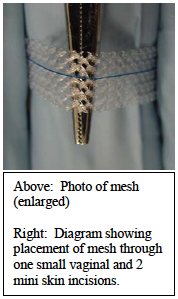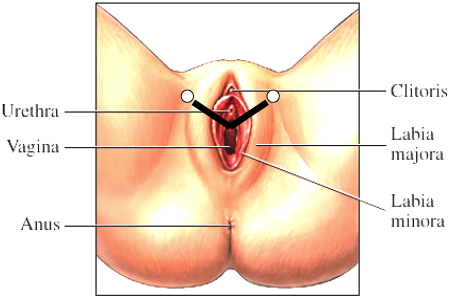transobturator sling
Transobturator Sling – Patient Information
What is it?
A minimally invasive, outpatient procedure to treat stress urinary incontinence
How is it done?
The procedure is The Lion King tickets done in the operating room, usually under sedation or general anesthesia. Three small incisions are made: a 1-cm incision in the vagina under the urethra and 2 mini incisions between the labia and the thigh. A ribbon of mesh is then placed under the urethra and brought out through the side incisions using specially designed instruments. The mesh is then adjusted to the proper tension, and the excess
mesh is trimmed at the skin. The incision in the vagina is closed with absorbable suture and the incisions in the labia/thigh region are closed with skin glue. The procedure typically takes 15 minutes and is ordinarily done as an outpatient.


How does it work?
The mesh lies under the urethra acting as a “hammock”. When abdominal pressure increases, as with a cough, sneeze or athletic activity, the sling provides a support to keep the urethra closed, preventing loss of urine. The bladder and urethra are not ‘sewn’ or ‘tacked up’, making this approach different from procedures that have been done in the past.
What are the risks?
- Failure to correct incontinence – This is the most common potential negative outcome. The procedure fails to correct stress incontinence in about 8% of patients. Another small percentage of patients have symptoms which are improved significantly, but not completely. If the surgery fails to make you dry, you may need to be re-evaluated to determine the cause. Medication, exercise, or another procedure may need to be considered in the future.
- Infection – This risk is low and you will be given antibiotics before and after the procedure.
- Bleeding – This risk is low, but you will be asked to stop aspirin, Coumadin, and other medications that may interfere with blood clotting a week before the procedure. After the procedure, you may experience bleeding similar to a light period for a day. There should not be bloody urine. If heavy vaginal bleeding does occur after surgery, it is usually managed by placing packing in the vagina
for several hours or overnight. The potential need for a transfusion is very low. - Urinary retention – If the sling is too tight you may experience difficulty emptying your bladder. This risk is small (less than 2%) and the majority of patients go home without a catheter. If you can’t void easily, you may have to have a catheter for a short amount of time. In rare cases, a second procedure to loosen the sling may be necessary.
- Mesh extrusion in the vagina – Rarely, the vaginal skin may not heal well over the mesh. This occurs in less than 2% of our patients. After healing you may feel some exposed mesh or a partner may feel the mesh during sexual relations. This may require a second procedure to remove the exposed mesh. If a large segment of mesh needs to be removed, it may cause the procedure to fail.
- Injury to the bladder or urethra – This risk, also, is rare. A cystoscopy may be done at the time of the procedure to visualize the bladder/urethra.
- Hip and Leg pain – The mesh is placed through the tendon of one of the inner thigh muscles. You may experience some soreness lasting a few days.
- Urinary urgency/urge incontinence – This procedure treats stress incontinence (leaking from coughing/sneezing/activity). It will not treat urge incontinence (leakage from uninhibited bladder contractions or ‘overactive bladder’). If a major part of your problem is urge incontinence, you should be careful to discuss this with your doctor before surgery. Many women have both stress and urge incontinence and often require separate treatments. A minority of women may have new onset of urgency following a sling procedure.
What are the restrictions following the procedure?
The mesh is not sewn into place – the small openings in the mesh allow the body’s tissues to grow into the mesh over time, providing lasting support. To allow this to happen, you will be asked to limit your activity for 4-6 weeks following the procedure to allow the mesh to become secure – no lifting anything over 15 lbs and nothing in the vagina (no intercourse/no tampons) for 4-6 weeks. You may shower, but no baths/swimming/hot tub soaks for at least 2 weeks. You may notice some of the absorbable suture material pass out of the vagina as it dissolves – this is normal. The skin glue used to close the groin incisions may be trimmed or peeled off after 2 weeks.
Most women have minimal discomfort following this procedure. About a third to half of our patients do not require a pain pill afterward. Of course, everybody is different, and in rare cases, patients may have bothersome pain afterwards. This is usually of short duration (days). You will be given a prescription for pain pills, and you should not drive or make important decisions if you need to take these medications. Most women are able to return to work (with lifting restrictions) in a 5 to 7 days.
What are the results?
Improvement can be seen immediately following the procedure. Long term data (7-8 years) with similar procedures indicate greater than 85% long-term cure. As discussed above, there is about an 8% failure rate for this type of surgery. That means it may not improve your leakage by at least 50%. Another small percentage will have a partial improvement of at least 50%. Some patients with mixed incontinence (stress and urge leakage) will continue to have urge incontinence afterwards, and they may require ongoing or additional treatment for that complaint. A small number of patients will develop new symptoms of urgency or urge incontinence following the surgery.
Other frequently asked questions:
- You do not need to shave or prep at home prior to the procedure. If a small amount of hair needs to be clipped it will be done at the time of the procedure.
- The procedure does not need to be scheduled around your period. However, you will need to use a pad, NOT A TAMPON, during the 6 weeks following the procedure.
